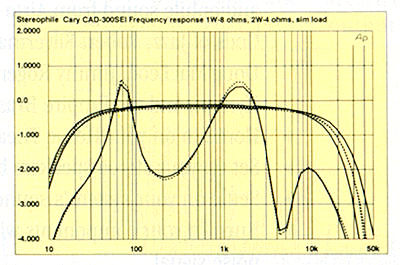| Columns Retired Columns & Blogs |
Cary Audio Design CAD-300SEI integrated amplifier Measurements
Sidebar 2: Measurements
Footnote 1: It is relatively simple to work out from Ohm's Law that the maximum transfer of power into a load occurs when the source impedance equals the load impedance. Thus the Cary's output impedance of 4 ohms means that it will deliver the maximum amount of power of which it is capable into a 4 ohm resistor. However, as loudspeakers are not power-driven but produce a sound-pressure output for a voltage input, and have impedances that can vary dramatically with frequency, the price to be paid for this maximal power transfer is a drastic modification of the amplifier's frequency response, as explained by Martin Colloms in April '95 ("The Unseen Variable," Vol.18 No.4, p.59). I would like those who propound the virtues of amplifiers with high output impedances to explain to the rest of us why this response modification is not important.—John Atkinson
Although I expected the 300SEI to have unusual measured performance, I wasn't prepared for the amplifier's extreme deviations from what we regard as good technical performance.
First, the 300SEI's output impedance was a whopping 4 ohms at 20Hz, 4.2 ohms at 1kHz, and 4.8 ohms at 20kHz. This is by far the highest output impedance I've measured in a power amplifier. With an output impedance roughly comparable to that of many loudspeakers' load impedances, we can expect significant departures from flat response when the 300SEI drives most loudspeakers (more on this later) (footnote 1).
Input impedance measured a typical 30k ohms, meaning the 300SEI won't load down source components connected to it. Voltage gain was 6.7 (16.5dB) with the volume halfway up, 14.7 (23.2dB) with the volume control wide open. The 300SEI doesn't invert absolute polarity.
Fig.1 shows the 300SEI's frequency response measured at 1W into 8 ohms, 2W into 4 ohms, and into the John Atkinson-modified NHT dummy load (8 ohms nominal). As explained last month (August '95, p.168), this load is designed to simulate the reactive load presented by a real-world loudspeaker (fig.2), not the purely resistive 8 ohm load found on a test bench. The 4 ohm pair of curves is the one with slightly greater treble rolloff and has been adjusted for the drop in absolute level.

Fig.1 Cary CAD-300SEI, frequency response at 1W into 8 ohms (top at 200Hz), 2W into 4 ohms (middle at 20kHz, adjusted for drop in absolute level), and into dummy load (top at 2kHz) (right channel dashed, 1dB/vertical div.).

Fig.2 Stereophile speaker simulator, electrical impedance (solid) and phase (dashed) (2 ohms/vertical div.).
The roller-coaster curve was taken with the 300SEI driving the simulated loudspeaker load. These frequency-response aberrations are severe: the entire upper midrange and treble are attenuated, as is the upper bass. Though the Infinity's variation of impedance with frequency (fig.3) is much less severe than our dummy load, I still heard this treble rolloff with the 300SEI and compensated for it by slightly toeing-in the Compositions, which are somewhat brighter-sounding on-axis. [Fig.4 shows the predicted response of the Cary driving the Infinity speaker, calculated from the impedance data in fig.3.Note tthat the shape of the response closely echoes the speaker's impedance plot. The rolloff in the bass is due to the inherent crossover to the speaker's powered subwoofer, but is inconsequential due to the speaker's rolloff below 120Hz.—Ed.] No such compensation was needed when driving the Compositions with the VT150s.

Fig.3 Infinity Composition P-FR, electrical impedance (solid) and phase (dashed) (2 ohms/vertical div.).

Fig.4 Cary CAD-300SEI, predicted frequency response into Infinity Composition P-FR loudspeaker (1dB/vertical div.).
Footnote 1: It is relatively simple to work out from Ohm's Law that the maximum transfer of power into a load occurs when the source impedance equals the load impedance. Thus the Cary's output impedance of 4 ohms means that it will deliver the maximum amount of power of which it is capable into a 4 ohm resistor. However, as loudspeakers are not power-driven but produce a sound-pressure output for a voltage input, and have impedances that can vary dramatically with frequency, the price to be paid for this maximal power transfer is a drastic modification of the amplifier's frequency response, as explained by Martin Colloms in April '95 ("The Unseen Variable," Vol.18 No.4, p.59). I would like those who propound the virtues of amplifiers with high output impedances to explain to the rest of us why this response modification is not important.—John Atkinson
- Log in or register to post comments




































